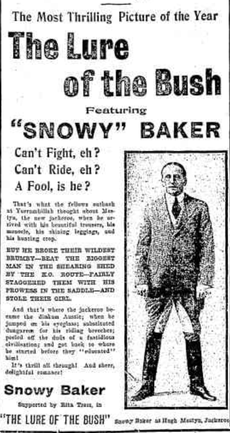Related Research Articles

Lotus Thompson was an Australian actress of silent and sound films. Her film career began in Australia in 1921 and ended in California in 1949, during which time she appeared in 35 motion pictures. She died in California in 1963.
Splendid Fellows is a 1934 Australian film from director Beaumont Smith about an Englishman who comes to Australia. The cast includes Eric Colman, brother of Ronald Colman, and Sir Charles Kingsford Smith, who has a cameo as himself. It was Smith's last film.

The Murder of Captain Fryatt is a 1917 Australian silent film about the execution of Captain Charles Fryatt during World War I from John and Agnes Gavin.
The Gentleman Bushranger is a 1921 Australian film melodrama from director Beaumont Smith. Bushranging films were banned at the time but Smith got around this by making the plot about a man falsely accused of being a bushranger.

The Church and the Woman is a 1917 Australian silent film directed by Raymond Longford set against the background of sectarianism in Australia. It is considered a lost film.
The Dinkum Bloke is a 1923 Australian silent film directed by Raymond Longford. Despite the title and the presence of Arthur Tauchert and Lottie Lyell in the cast, the film is not a direct sequel to The Sentimental Bloke (1919) or Ginger Mick (1920).

The Enemy Within is a 1918 Australian silent film starring renowned Australian sportsman Snowy Baker in his first screen role.

The Lure of the Bush is a 1918 Australian silent film starring renowned Australian sportsman Snowy Baker. It is considered a lost film.
Walter Franklyn Barrett, better known as Franklyn Barrett, was an Australian film director and cinematographer. He worked for a number of years for West's Pictures. It was later written of the filmmaker that "Barrett's visual ingenuity was to be the highlight of all his work, but... his direction of actors was less assured".
The Breaking of the Drought is a 1920 Australian silent film from director Franklyn Barrett based on the popular play by Bland Holt and Arthur Shirley. According to Graham Phillips, this film is one of the most damaged films in Australia's film archive, although few sequences have severe damage in the film.
The Mystery of the Black Pearl is a 1912 Australian silent film. A detective drama, It is now considered a lost film.
The Eleventh Hour is a 1912 Australian silent film. It is considered a lost film.
A Silent Witness is a 1912 Australian silent film directed by Franklyn Barrett. It is considered a lost film. It was a drama set in Sydney with Cyril Mackay as the hero.
A Blue Gum Romance is a 1913 Australian silent film directed by Franklyn Barrett. It is considered a lost film.
The Monk and the Woman is a 1917 Australian silent film directed by Franklyn Barrett. It is considered to be lost.

A Girl of the Bush is a 1921 Australian silent film directed by Franklyn Barrett. It is one of the few films from Barrett to survive in its entirety today.

A Rough Passage is a 1922 Australian silent film directed by Franklyn Barrett based on the novel by Arthur Wright. It was Barrett's final feature and is considered a lost film.

Vera James Munro was a New Zealand actress who worked in theatre and film. In 1929 she appeared in the first all-talking, all-colour feature length movie ever made, Warner Bros On with the Show!, and was already well known for starring in A Girl of the Bush in 1921.
Rushcutters Bay Studio was an Australian film studio built by Charles Cozens Spencer in 1912 at Rushcutters Bay, Sydney.
A Message from Mars is a 1903 New Zealand short film by Franklyn Barrett, based on the play of the same name by Richard Ganthony that had been highly popular in Australia and New Zealand.
References
- ↑ "THE LYCEUM". The Sydney Morning Herald . National Library of Australia. 8 October 1921. p. 16. Retrieved 10 May 2012.
- ↑ Edmondson, Ray; Pike, Andrew (1982). "Australia's Lost Films" (PDF). National Library of Australia. p. 64. Retrieved 13 March 2013.
It would be hard to guess the significance of the rediscovery of, say, Longford's Ginger Mick or Barrett's Know Thy Child ...
- ↑ "Know Thy Child". silentera.com. Retrieved 4 March 2013.
- ↑ ""KNOW THY CHILD"". The Daily News . Perth, WA: National Library of Australia. 6 January 1922. p. 6. Retrieved 10 May 2012.
- ↑ ""KNOW THY CHILD!"". The Register . Adelaide: National Library of Australia. 24 January 1922. p. 9. Retrieved 10 May 2012.
- ↑ Barrett, Franklyn (10 December 1930), "Please, Mr. Policeman, May I Make a Movie? For "Everyones" by Franklyn Barrett.", Everyones, Sydney: Everyones Ltd, nla.obj-564399119, retrieved 16 August 2024– via Trove
- 1 2 Andrew Pike and Ross Cooper, Australian Film 1900–1977: A Guide to Feature Film Production, Melbourne: Oxford University Press, 1998, 108.
- ↑ "THE PASSIONATE PILGRIM". The Sunday Times . Sydney: National Library of Australia. 12 June 1921. p. 12. Retrieved 10 December 2014.
- ↑ "FIGHTING CRESSY". The Sunday Times . Sydney: National Library of Australia. 26 June 1921. p. 14. Retrieved 4 October 2014.
- ↑ "OUTSIDE THE LAW". The Sunday Times . Sydney: National Library of Australia. 3 July 1921. p. 14. Retrieved 10 December 2014.
- ↑ "TO THE SUNSHINE". The Sunday Times . No. 1844. New South Wales, Australia. 29 May 1921. p. 5. Retrieved 12 March 2017– via National Library of Australia.
- ↑ "AUSTRALIAN FILMS". The Register . Adelaide: National Library of Australia. 22 October 1927. p. 13. Retrieved 10 May 2012.
- ↑ "THE PICTURES". The Argus . Melbourne: National Library of Australia. 24 November 1921. p. 8. Retrieved 10 May 2012.